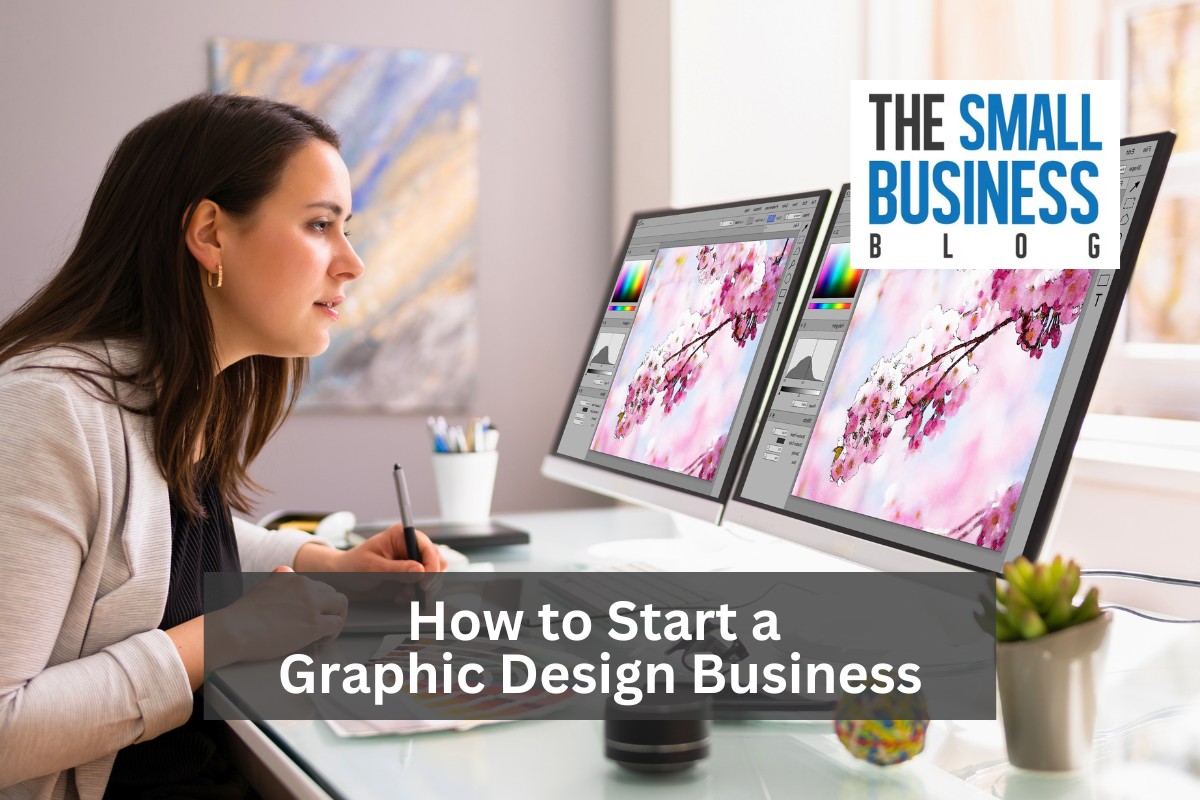Starting a graphic design business is a rewarding journey combining creativity and entrepreneurship.
Many people are exploring it but don’t know where to start.
In this guide, we will explore how to start a graphic design business, breaking down the essential steps and strategies you need to turn your love for design into a thriving enterprise.
It doesn’t really matter if you’re a seasoned designer or just starting out; we will help you successfully negotiate the road to success in the demanding field of graphic design.
Let’s dive into the practical side of building your Graphic Design Business, where your passion meets your profession.
Post Contents
- 1 How to Start a Graphic Design Business
- 2 Benefits of Starting a Graphic Design Business
- 3 Frequently Asked Questions
- 4 Conclusion
How to Start a Graphic Design Business
Let’s look at the steps in detail right from the beginning.
1. Develop Your Graphic Design Skills

Before you embark on your entrepreneurial journey in the graphic design industry, it’s crucial to lay a solid foundation for your skills.
Your proficiency in graphic design is your primary asset, so invest time and effort in sharpening it.
Familiarize yourself with design software tools like Adobe Creative Suite, which includes industry standards like Photoshop, Illustrator, and InDesign.
These tools are your brushes and canvases, so mastering them is paramount.
Beyond software, never underestimate the importance of your artistic abilities.
You must always practice drawing, painting, and sketching to enhance your creative skills.
The design world is dynamic, with trends that come and go.
To remain relevant, keep an eye on the latest design trends, follow design blogs, attend webinars, and participate in workshops to stay up-to-date with what’s in demand.
2. Defining Your Niche
Your journey begins with introspection.
Take a moment to delve into your interests and strengths within graphic design.
Ask yourself what aspects of design you excel at and, more importantly, what genuinely resonates with you.
Your niche should be an authentic reflection of your passions and talents.
By aligning your niche with your genuine interests, you’ll be more motivated and satisfied in your work.
Next, you have to consider the market’s demands.
Consider the specific needs of your target audience and look for gaps in the market that align with your niche.
Understanding what potential clients are seeking can help you tailor your services to meet those needs effectively.
To stand out in a competitive field, you must investigate what your competitors are offering.
By studying the services your peers provide, you can identify opportunities for differentiation.
For example, if your competitors predominantly focus on web design, you might specialize in logo creation or branding.
The goal is to find a unique selling proposition (USP) that sets you apart from the crowd.
A SWOT analysis is a valuable tool for evaluating your business’s Strengths, Weaknesses, Opportunities, and Threats.
By conducting this analysis, you can create a strategic plan that leverages your strengths, mitigates weaknesses, capitalizes on opportunities, and safeguards against threats.
This well-rounded approach ensures you make informed decisions about your business’s positioning and overall strategy.
3. Branding Your Business
Creating a distinct brand identity is not just about a logo or a catchy tagline; it’s about crafting an image that encapsulates your style and values. Here’s a deeper look into this process:
1. Visual Identity
Your brand’s visual identity includes your logo, color palette, and typography.
These elements should be thoughtfully chosen to convey the essence of your business.
Remember that consistency in design across all materials and platforms is vital.
2. Brand Voice
Beyond visuals, consider your brand’s voice.
Is it formal, friendly, or casual?
Your communication style should align with your target audience and the image you want to project.
3. Mission and Values
Define your mission and values clearly.
Your clients should understand what you stand for and what drives your creative work.
This can help you connect with like-minded individuals and businesses.
4. Brand Story
Narratives are powerful.
Your brand story should be authentic and relatable, giving clients a glimpse into your journey, inspiration, and passion for graphic design.
4. Setting Up Your Office

A productive workspace is crucial for creativity and efficiency.
When setting up your office, consider the following:
- Ergonomics – Invest in ergonomic furniture, such as a comfortable chair and an adjustable desk. These tools can enhance comfort and help prevent strain during long work hours.
- Lighting – Natural light is ideal, but if that’s impossible, invest in quality lighting fixtures. Proper lighting can reduce eye strain and create a pleasant working environment.
- Organizational Tools – Keep your workspace organized with storage solutions like shelves, drawers, and desk organizers. A clutter-free workspace can boost productivity.
- Technical Equipment – High-quality computers and other technical equipment are essential for graphic designers. Ensure your devices are up to date and capable of running the software you need efficiently.
- Software Selection – Invest in the latest design software and tools that enhance productivity and creativity.
5. Building an Online Presence
An online presence is probably the most important part today when talking about these high-income skills.
1. Professional Website
Your website is your digital portfolio.
Make sure it’s professional, user-friendly, and showcases your best work.
It should also include a clear description of your services, contact information, and client testimonials.
2. Social Media Engagement
Utilize social media platforms to expand your online reach.
Regularly update your profiles with your latest projects and engage with your audience on platforms like Facebook, Instagram, and TikTok.
3. Content Creation
Consider creating informative content, such as blog posts or videos, related to graphic design.
Sharing your knowledge can establish you as an industry authority and attract potential clients.
6. Attracting Your First Clients
Attracting your first clients, especially when just starting, can be challenging but crucial in building your reputation and client base.
To tackle this hurdle, you can begin by leveraging your network, reaching out to friends, family, and acquaintances who might require design services or know someone who does, as personal connections can provide valuable referrals and initial projects to build your portfolio.
Offering competitive rates in the initial stages can be an attractive incentive for clients looking for quality design work within a budget.
Additionally, providing exceptional customer service by promptly responding to inquiries, meeting deadlines, and ensuring client satisfaction can lead to more referrals.
It’s also essential to create a professional portfolio showcasing your best projects, as an impressive portfolio not only attracts clients but also demonstrates your skills and expertise.
7. Managing Your Finances

While this is not a mandatory step, effective financial management is another key part of the sustainability of your business.
- Accounting Software – Invest in accounting software to keep track of your income and expenses. This software can streamline the process, help you generate financial reports, and ensure compliance with tax regulations.
- Tax Planning – Set aside funds for taxes from the beginning. To learn more about your tax responsibilities, deductions, and the best ways to manage your finances for taxation, speak with a tax expert.
- Budgeting – Create a detailed budget that outlines your projected expenses, including software subscriptions, marketing costs, and equipment upgrades. This budget will help you make informed financial decisions.
- Emergency Fund – Building an emergency fund can provide a financial safety net for unexpected expenses or lean periods in your business. It’s a prudent financial practice that can safeguard your business.
8. Networking and Professional Growth
The world of graphic design is dynamic and ever-evolving.
Staying connected with your peers and continuously enhancing your skills is essential for professional growth.
1. Industry Events
Attend graphic design conferences, seminars, and workshops.
These events provide opportunities to learn about industry trends, network with professionals, and gain fresh insights.
2. Design Associations
Join design associations and organizations.
These memberships can provide access to valuable resources, networking events, and professional development opportunities.
3. Online Communities
Participate in online design communities and forums.
Platforms like Behance, Dribbble, or LinkedIn groups allow you to connect with fellow designers, share your work, and gather feedback.
4. Collaborations
Consider collaborating with other designers on projects.
Collaborations can not only broaden your skill set but also introduce you to new client bases through your collaborators’ networks.
Benefits of Starting a Graphic Design Business

Starting a Graphic Design Business offers various benefits, including:
1. Creative Freedom
As a graphic designer and business owner, you have the freedom to choose the projects you work on, allowing you to express your creativity and work on designs you are passionate about.
2. Flexibility
Running your own business provides flexibility in terms of work hours and location.
You can work from home, set your schedule, and adapt your workload to your personal needs.
3. Potential for High Income
Graphic designers with a strong client base and a solid portfolio can earn a substantial income.
Your income potential increases as you gain experience and a reputation for high-quality work.
4. Diverse Client Base
Graphic design is needed across various industries, from advertising and marketing to web design and print media.
This diversity offers the opportunity to work with a wide range of clients and projects.
Frequently Asked Questions
How much should I charge for my graphic design services?
Your pricing should be competitive and reflective of your skills and experience.
Consider factors like the project scope and client budget.
Do I need formal training to start a Graphic Design Business?
While formal training is beneficial, many successful graphic designers are self-taught.
A strong portfolio and skills are more important than formal education.
How can I attract clients as a new graphic design business?
Start by leveraging your personal network, offering competitive rates, and creating an impressive online portfolio.
Excellent customer service is key to building a solid client base.
Conclusion
Starting a Graphic Design Business involves creativity, strategy, and persistence.
We’ve explored the fundamental steps, but it’s up to you to do the hard work and get started because the graphic design world offers immense potential for those who are not only artistic but also hard-working.
So, if you were considering how to start a graphic design business, now you know the answer, but remember that it’s not just about design—it’s about creating a successful enterprise that resonates with your style and values.
As you navigate this industry, stay inspired, continue to learn, and build a solid client base that values your unique vision and skills.






























